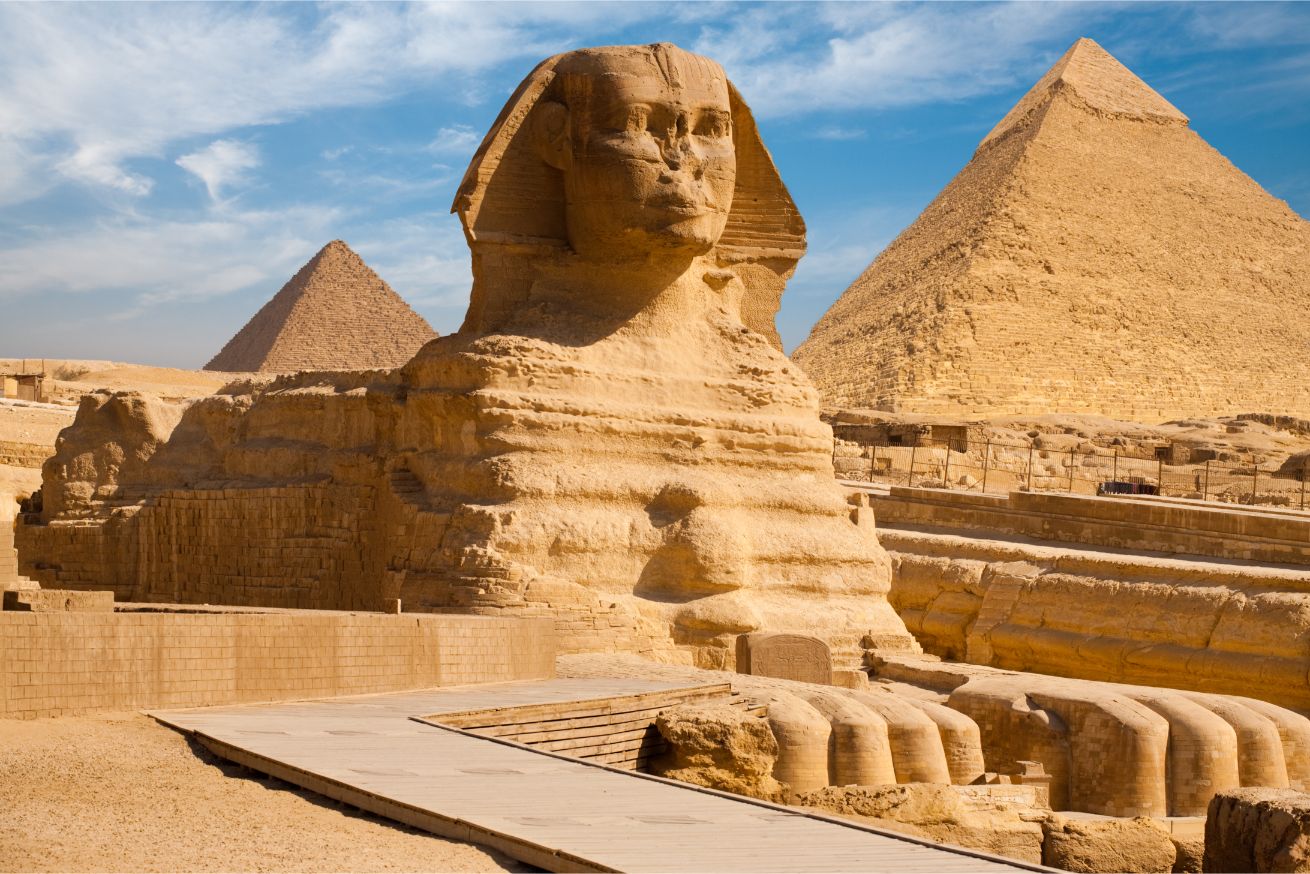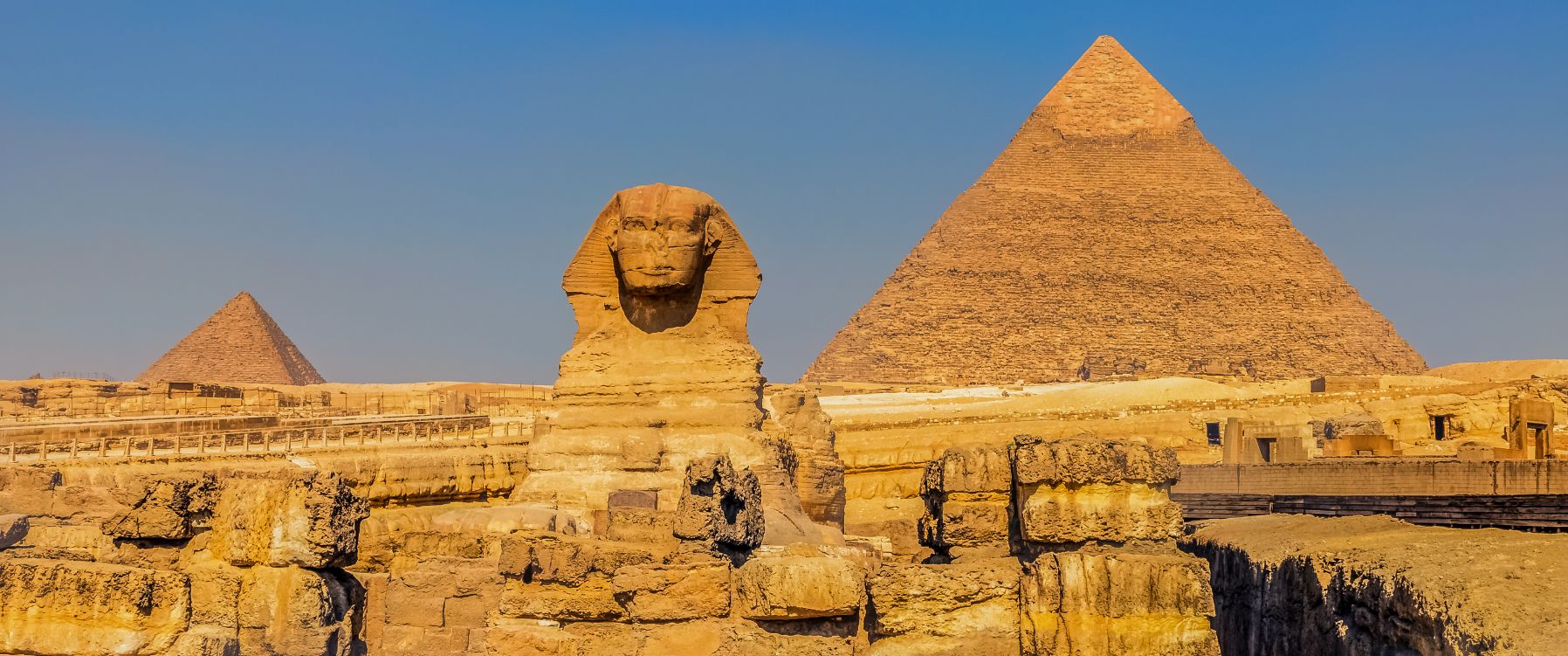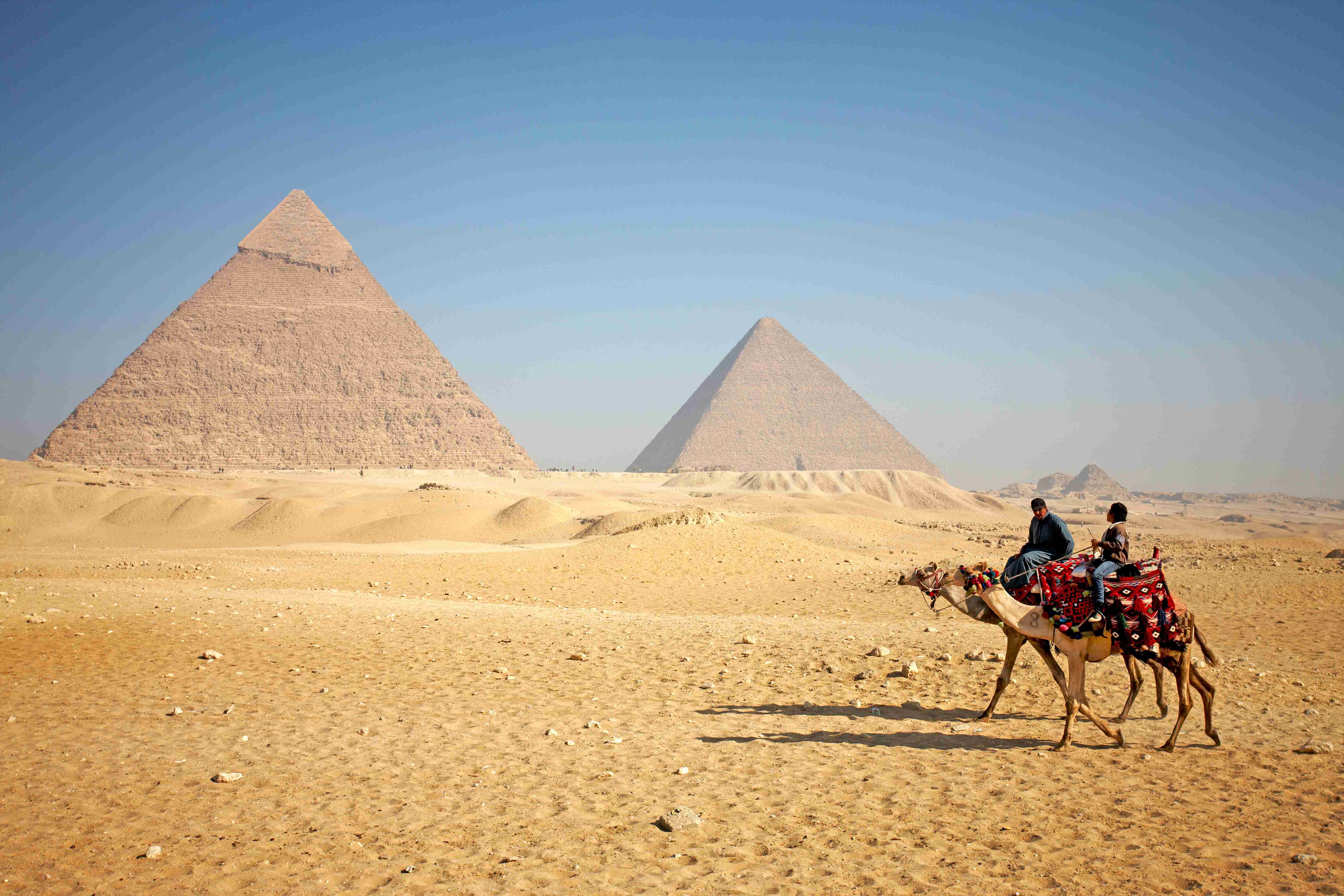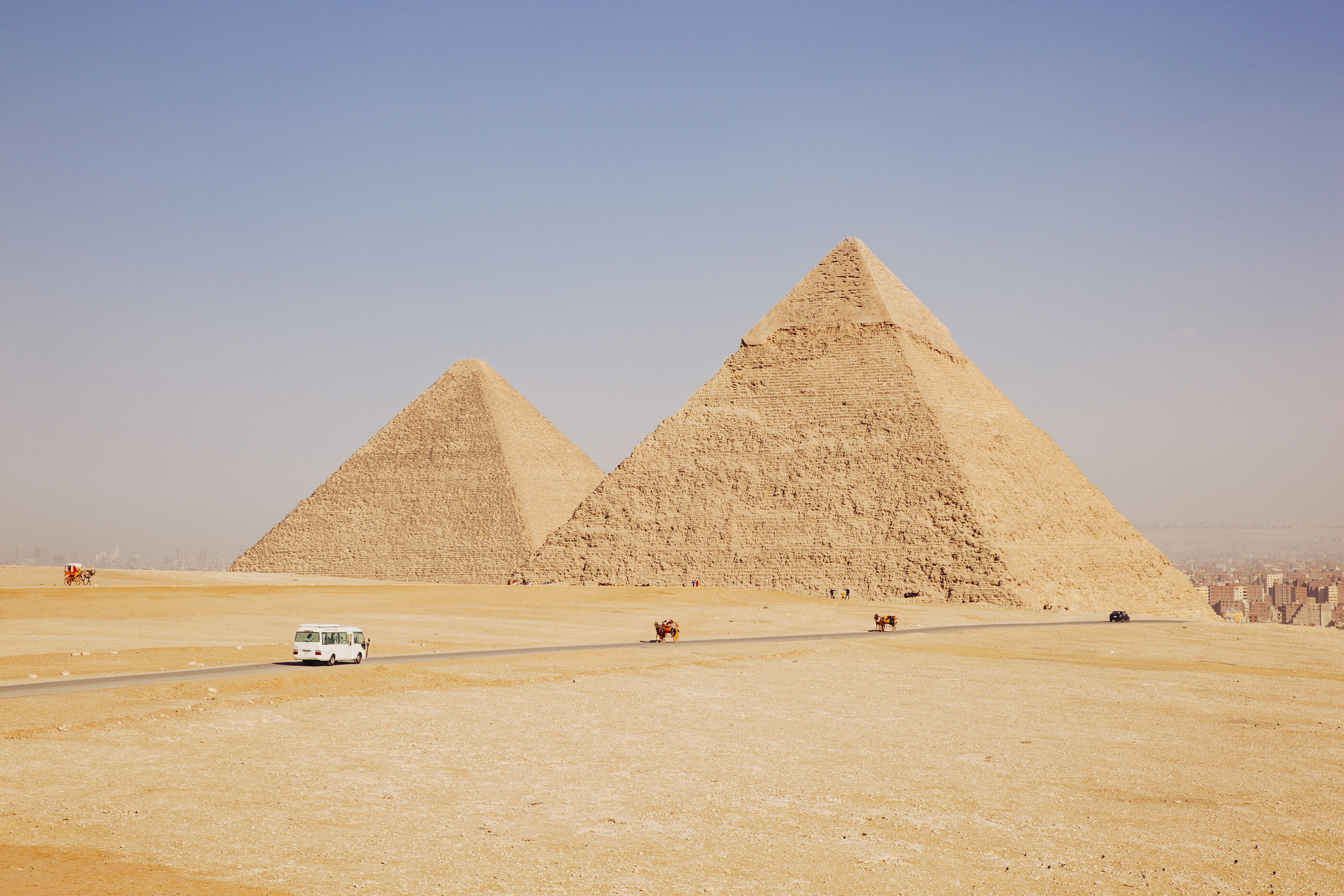
Mysteries of the Sphinx between Myths and Facts
Let's Separating Myth from Monumental Fact
For over 4,500 years, the Great Sphinx of Giza has stood as a silent guardian of the desert, its lion body and human head embodying both strength and wisdom. Yet, its mysteries run far deeper than its imposing form.
Archaeologists and historians continue to debate its true age, original purpose, and even the identity of the face it bears. Some believe it represents Pharaoh Khafre, while others suggest it may predate his reign entirely. Weathering patterns fuel theories of an even older origin, challenging long-held timelines of ancient Egyptian civilization.
What secrets does the Sphinx still hold? Join us as we unravel fact from myth, exploring the fascinating stories behind one of history’s most enigmatic monuments.
Origins of the Great Sphinx
Carved from a single massive limestone block, the Great Sphinx of Giza stands as a testament to ancient Egyptian engineering brilliance. Believed to have been built during Pharaoh Khafre’s reign around 2500 BCE, this awe-inspiring monolith stretches 240 feet in length and rises 66 feet high.
Ancient builders meticulously sculpted the Sphinx by excavating a natural limestone outcrop, shaping the lion’s powerful body, including its paws and tail, while crafting a regal face adorned with a royal headdress. At nearly 34 feet high, the face exhibits remarkable precision, and archaeological evidence suggests it bears the likeness of Pharaoh Khafre himself. Positioned at the entrance of his pyramid complex, the Sphinx likely served as a symbolic guardian, protecting the sacred site.
However, time has not been kind to this ancient sentinel. The Sphinx was largely buried under desert sands by the New Kingdom era, and Pharaoh Thutmose IV, around 1400 BCE, attempted to uncover it, though he managed to reveal only its legs. Centuries of wind and sand erosion have further weathered its features, adding to its air of mystery.
Despite these challenges, the Great Sphinx remains an enduring icon of ancient Egypt, inviting us to uncover the secrets hidden beneath its weathered gaze.
The Sphinx Lost Its Nose
One of the most dramatic changes to the Great Sphinx occurred in the 14th century. According to historical accounts, Muhammad Sa’im al-Dahr, a Sufi mystic, witnessed local peasants making offerings to the Sphinx in hopes of improving their harvests. Viewing this as idolatry, he allegedly defaced the statue, breaking off its nose and damaging part of its mouth actions that ultimately led to his execution.
Modern archaeological interest in the Sphinx began in 1817 when Italian explorer Giovanni Battista Caviglia led one of the earliest excavations. However, it wasn’t until the 20th century that the Sphinx was fully uncovered. By the 1920s, erosion caused parts of its headdress to collapse, prompting extensive restoration efforts. French Egyptologist Emile Baraize finally completed the first full excavation in 1926, revealing the entire structure that continues to captivate visitors and scholars alike.
Sphinx Across Ancient Cultures
The Sphinx, a mythological creature with the body of a lion and the head of a human, held great significance across various ancient civilizations. Its symbolism and purpose evolved over time, reflecting the cultural and religious beliefs of different societies.
The First Identifiable Sphinx Statues
The sphinx's legacy continues through generations, evolving from a symbol of divine power to an archeological mystery. Giovanni Battista Caviglia started the first modern excavation in 1817. His work helped reveal an array of cultural interpretations surrounding these ancient monuments and showed how different civilizations adapted this powerful symbol.
Egyptian history reveals that the Sphinx embodied both male and female characteristics. Between 2700 and 2500 BCE, Queen Hetepheres II created one of the earliest known sphinx statues featuring a woman's face. Many pharaohs and queens continued this tradition, depicting themselves as sphinxes across multiple dynasties.
In Egyptian mythology, the Sphinx represented the solar deity Horemakhet, also known as Horus of the Horizon. New Kingdom records show that these majestic creatures symbolized sacred royalty and divine power, with their royal headdresses reinforcing their connection to the pharaoh's authority.
Greek mythology, however, portrayed the Sphinx quite differently. The Greek version had a female head and eagle wings, though its origins were often linked to Africa, particularly Ethiopia. Unlike its Egyptian counterpart, the Greek Sphinx was seen as a menacing creature that posed riddles to travelers. Its most famous challenge, posed to Oedipus, asked, "What walks on four feet in the morning, two feet at noon, and three feet in the evening?

Beyond their symbolic significance, sphinx statues served as guardians of sacred sites and temples in ancient Egypt. Even after Egypt's decline, local communities continued to believe in the Sphinx’s mystical powers. This enduring reverence ultimately led to the defacement of the Great Sphinx’s nose in the 14th century.
The Sphinx’s legacy endures across generations, evolving from a symbol of divine power to an enduring archaeological enigma. The first modern excavation, led by Giovanni Battista Caviglia in 1817, uncovered new insights into its historical and cultural significance. His work helped illuminate the many ways civilizations across time have interpreted and adapted this iconic figure.
Scientific Discoveries vs Legends
Archaeological discoveries continue to unveil fascinating insights about the Great Sphinx, challenging long-held beliefs about its origins, purpose, and history. Each new finding reshapes our understanding of this ancient monument, revealing deeper connections to Egyptian civilization and its enduring mysteries.
Mysteries of the Sphinx
Recent excavations have uncovered remarkable details about the construction of the Great Sphinx. Carved from a single limestone outcrop, it stands as one of the largest monolithic sculptures in the world. The ancient builders carefully excavated a deep trench around the natural bedrock, sculpting the lion’s body directly from the exposed stone. This technique not only provided structural stability but also demonstrated their advanced understanding of engineering and resource management.
The Sphinx's Hidden Truths
Scientists have confirmed that natural forces have significantly impacted the Great Sphinx over thousands of years. Wind and sand erosion have gradually worn down its features, leaving visible marks on the monument. Efforts to preserve the statue date back to the reign of Thutmose IV, who attempted to clear the encroaching sand and reinforce the structure. However, these early restoration attempts were not enough to fully protect it from the relentless effects of weathering
Inside the Great Sphinx
Is there a hidden world within the heart of the Great Sphinx?
For centuries, this colossal guardian has stood watch over the Giza Plateau, its enigmatic gaze locked on the horizon. But could its weathered limestone exterior conceal long-lost chambers or undiscovered passages?
Legends and modern theories alike suggest that the Sphinx may hold secrets beneath its surface: hidden rooms, ancient texts, or even pathways leading to forgotten knowledge. Some believe tunnels may connect it to the Pyramids of Giza, while others speculate about chambers yet to be explored.
Join us as we dive into the mysteries of the Great Sphinx, where myth meets potential reality. Are its greatest secrets still waiting to be uncovered?
Sphinx Mythology
The Sphinx's significance extended far beyond mere symbolism, embodying both royal power and sacred status. Records from the New Kingdom period reveal that these majestic creatures were closely linked to divine kingship. Their depiction wearing the royal Egyptian headdress reinforced their connection to pharaonic authority, making them enduring symbols of strength and legitimacy.
Even after the decline of ancient Egypt, the Sphinx's mystical influence persisted. Local peasants believed it held supernatural powers, capable of enhancing crop yields. This widespread reverence led to unofficial worship, which ultimately had unintended consequences. In the 14th century, Muhammad Sa’im al-Dahr, disapproving of such practices, defaced the Great Sphinx, destroying its nose in an act of religious opposition.
The Sphinx’s mythological reach extended well beyond Egypt’s borders. In Greek mythology, it took on a different form, typically depicted with female features and eagle wings. Greek storytellers acknowledged its African origins, often tracing its homeland to Ethiopia. However, unlike the protective Egyptian Sphinx, the Greek version became known for its cunning and menacing nature, famously challenging travelers with intricate riddles, the most well-known being its encounter with Oedipus.
Across civilizations, the Sphinx evolved in both form and meaning, cementing its place as one of history’s most enduring and enigmatic figures.
The Double Sphinx Mystery
The Sphinx's Lost Sister
The idea of a second Sphinx standing alongside the Great Sphinx of Giza is a tantalizing theory that challenges our understanding of Egypt’s most iconic monument. Imagine the Giza Plateau not with one but two colossal guardians watching over its ancient mysteries.
Renowned Egyptologist Bassam El Shammaa has spent years studying this possibility. He suggests that a second Sphinx, a female counterpart, once stood beside the one we see today. According to his theory, this twin structure may have been lost to time, eroded by natural forces, or even deliberately dismantled in antiquity.
Ancient Egyptian mythology often emphasized duality, sun and moon, life and death, and Upper and Lower Egypt. If a second Sphinx did exist, it might have represented balance, mirroring the divine symmetry seen in many aspects of Egyptian art and architecture.
While no definitive evidence has been found to prove this lost twin, some researchers point to anomalies in the Giza landscape and ancient texts that hint at a missing structure. Could remnants of a second Sphinx still lie buried beneath Egypt’s sands, waiting to be discovered? The mystery continues to captivate scholars and enthusiasts alike.
For more than four millennia, the Great Sphinx has stood watch over the Giza Plateau, remaining one of humanity’s greatest achievements. While scientists have uncovered many secrets about its construction and history, this ancient wonder still holds countless mysteries.
Archeological evidence firmly links the Sphinx to Pharaoh Khafre’s reign, yet its influence extends far beyond ancient Egypt. Greek mythology reimagined the creature as a riddle-speaking guardian, while medieval legends attributed magical powers to it.
Time and nature have taken their toll on this limestone colossus, leading to centuries of preservation efforts since its first modern excavation. Despite erosion and human intervention, the Sphinx continues to command awe, its massive form captivating visitors from around the world.
With every new archeological discovery, another chapter of its story unfolds. The Great Sphinx is a testament to human creativity, artistic mastery, and the enduring power of mystery. Perhaps some secrets of the past will never be fully revealed, and that is precisely what makes them so fascinating.
Related Articles

What makes the Great Pyramid unique?
If you're a history enthusiast or simply an avid traveler, then exploring the Great Pyramid in Egypt is an experience that should be on your bucket list. As one of the Seven Wonders of the Ancient World, the Great Pyramid stands as a testament to the incredible architectural prowess of the ancient Egyptians and their fascination with the afterlife. In this article, we'll delve into the fascinating history and significance of the Great Pyramid, as well as provide practical tips for visiting this awe-inspiring monument in the land of the pharaohs. So get ready to embark on a virtual journey and discover the wonders of the Great Pyramid!

Top Mysteries Facts about the great Pyramids of Giza
The Great Pyramid of Giza stands as humanity’s most mysterious architectural triumph.

Beyond Giza … The True Number of Pyramids in Egypt
The iconic trio of pyramids at Giza leads many to believe they know everything about Egyptian pyramids.
